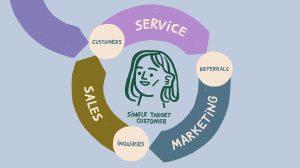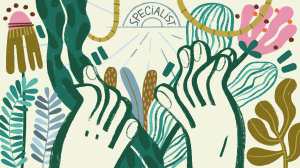Written by Amal Abdalhay
We interviewed business owners and marketing managers to learn how they use social media for their interior design firms and get the highest ROI from platforms like Instagram, Clubhouse, Pinterest, LinkedIn and TikTok.
When it comes to the interior design industry, there’s a growing need for designers to market their businesses online. A big chunk of that marketing will take place on social media, so which platforms are best to use? And what content should be leveraged across those platforms to help you achieve your business goals?
In this post, we are suggesting a more important question to ask. Read on to find out what that question is, the reason you should be thinking about it as an interior designer, and what role social media inevitably plays for interior design.
Instead of Figuring Out the Platform, Figure Out the Customer
As a digital marketing agency, designers often ask us: Which social media platforms should I focus on? And is Google better than social media for my business?
During our talk at the Interior Design Show in Toronto last month, our founder, Daniela Furtado, explained that the reality is: the platform doesn’t matter! It’s irrelevant. Your focus should be on your audience, not the platform.
Being clear on who your target audience is, what they want and what resonates with them will help you choose the right social media platform. So, a better question would be: Who is my audience?
Understanding your audience and their psychology is key to developing effective, targeted content that speaks to your ideal customer’s goals and challenges. Think about every interaction with your customers and ask yourself:
- Who is contacting you and signing the cheque?
- Which platforms do they use?
- What do they want? Break down their emotional desires and fears.
- What is blocking them from getting what they want? Their doubts, questions, and concerns.
In a crowded media space, audiences only listen if the message is meaningful to them. Having a clear picture of who you’re marketing to, what social media channels they use, and most importantly, what motivates them to buy, will help you tailor messages that resonate and leave a memorable impact. This approach will help you create a marketing strategy that is designed to get them from lurking you online to contacting you offline.
Which Social Media Platforms Are Best for Interior Design?
Once you know who your audience is and what social media channels they use, choosing the right platform is key to building brand awareness and engagement. Social media for interior design can help you build brand recognition and nurture your followers into clients.
If you’re interested in exploring other channels outside of social media, we’ve written about search engines and public relations here:
- A Beginner’s Guide on SEO for Interior Designers
- A Guide to Google Ads for Interior Designers
- Interior Design PR: How to Get Published in Design Magazines
We interviewed a few interior design companies, that have an impressive presence online and are able to successfully reach their target audience across different social media platforms. They explained how the expansive reach of social media can be used to drive business, and they shared some tips and lessons learned from their experiences.
Instagram for Interior Designers
A visual playground for interior designers, Instagram is a great platform to showcase your work and what you’re up to. It’s the visual story that inspires your audience and allows you to connect with them.
When we asked Lara Joubert, a Visual Storyteller at LUX decor, a full-service interior design and decor studio, to tell us about the time and effort they put into their Instagram account that has 46.5K followers, she told us, “we have a Content Creator working part-time on our main account @lux.decordesign organizing all the posts, and a full-time Visual Storyteller capturing all the content (photo/video), in addition to a full-time Marketing Intern working on engaging on the account daily.”
According to Joubert, the firm gets most of their leads through referrals and some through Instagram. LUX decor utilizes the platform to maintain and build customer loyalty, and as a result, it keeps clients coming back when they have an interior project in mind.
The leads that the firm gets are looking for residential interior design. Some of them chose to renovate or decorate (or both) one room, and some are interested in redoing the whole house.
The marketing team posts every day at 9 am and some days at 12 pm, they’re constantly looking at the metrics and readjusting. “We post a variety of static and video content and are always adapting to the trends,” Joubert added.
Joubert’s advice for designers using the Instagram platform: “Instagram has an ever-evolving algorithm, and you need to keep up to date on what’s trending as well as produce content that answers a need and entertains. We like to show the faces (staff), behind the designs as well because people can relate to us better.”
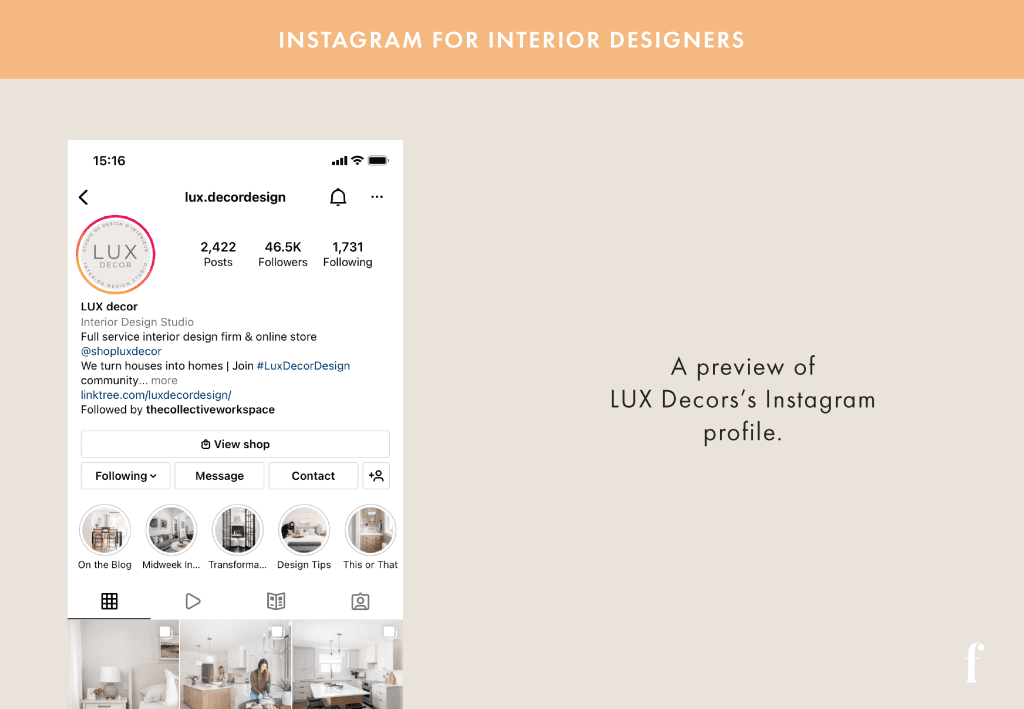
Clubhouse for Interior Designers
Hearing so much about Clubhouse? Blame it on Elon Musk, after he entered one of the chatrooms back in 2021, the platform gained so much attention. Clubhouse was launched in 2020 as an audio-chat social network. This platform offers a page full of conversational topics to follow, in each you’ll find people interested in the same topic and you can also follow them. There are no pictures or videos on the app, only a profile picture for each user. So how can Clubhouse help you grow your interior design business?
We asked Charmaine Wynter, the founder of Charmaine Wynter Interiors, a bespoke luxury design firm, how does the platform help her grow her interior design business? She told Findable Digital Marketing that, “Clubhouse has been a game-changer for my interior design business in that the information exchanged in our room, Design Masters Group (DMG), are the type it would take years for me to acquire through life lessons.”
Wynter founded Design Masters Group in April of 2021, and it has grown to be the largest industry club on the platform with 1.8K members.
DMG is a global network of peers working together to tackle shared industry challenges via education, collaboration, and community. Some of the topics that are discussed in the room include: client relationships, home staging, conflict resolution, social media marketing, design business laws and finance with the goal of elevating the design industry.
And for the type of leads Wynter gets through Clubhouse, Charmaine shared with us that she has gotten design jobs, speaking engagements and she’s currently in talks now for a network show.
Wynter’s advice for designers using the Clubhouse platform: “Only believe half of the things you hear on Clubhouse.”
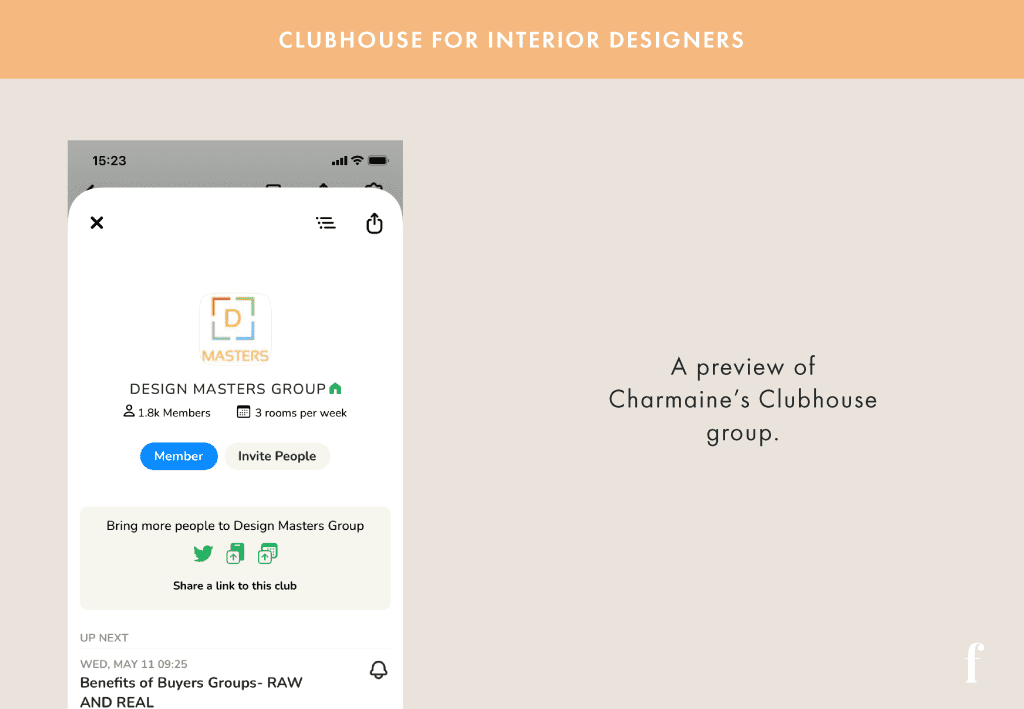
LinkedIn for Interior Designers
LinkedIn is the number one business network. It works best as a professional foundation and insider platform for interior designers. It is where you can network, follow trends with fellow designers, demonstrate your expertise, and direct some traffic to yourself.
During our interview with Ian Rolston, Director of Black Architects and Interior Designers Association (BAIDA) and Founder of Decanthropy, about the role LinkedIn played in his career, Rolston shared that LinkedIn has been a great platform to raise awareness, connect with other practitioners and serve as a point of contact.
For BAIDA, a non-profit organization that aims to support diversity in the architecture and interior design industry, the goal is to share the organization’s perspective of design and connect with other professionals. LinkedIn, therefore, is leveraged to grow the community by sharing BAIDA’s values and mission, connecting to established and emerging leaders, spotlighting current members, and supporting other organizations that are doing similar work. As a result, BAIDA is becoming the point of contact for companies and individuals who want to support the initiative.
Rolston’s advice for designers using the LinkedIn platform: “Be authentic. Don’t associate your value to how many likes you get. Define what success means to you and your brand. Find your own meaning that works within your space.”
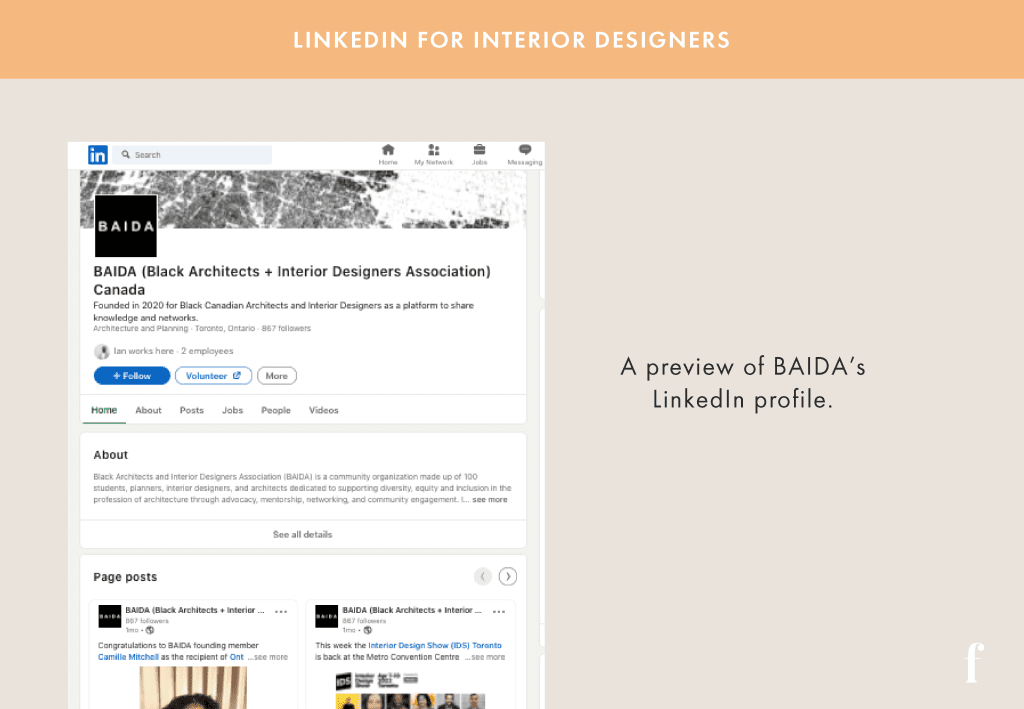
Pinterest for Interior Designers
Pinterest is a visual search engine, which makes it a great digital catalogue for interior designers to showcase their design and style esthetic on social media.
As of the first quarter of 2022, Pinterest had 433 million monthly users worldwide. And according to Hootsuite 2022 digital trend report, 86.2% of Pinterest users also use Instagram. This makes the platform a no-brainer for vendors targeting DIYers or designers that have a shop. The platform is a powerful tool for e-commerce. It is where homeowners spend time researching and saving ideas for projects they want to undertake. It is where your future client is, and it’s where you should be too.
Some accounts that we admire and have been taking advantage of the platform include Emily Hendersonand, Sarah Earl, and Arlyn Hernandes.
TikTok for Interior Designers
TikTok is a social media platform centered around short videos. In September 2021, the platform reported 1 billion monthly active users worldwide. With this many users, it is definitely worth exploring for interior designers. TikTok videos could be great for project tours and processes, behind-the-scenes and before-and-after reveals.
Some accounts that we admire and have been taking advantage of the platform include: @HouseOfHipsters, @jaclynhdesigns, @kellywearstler
The platform is relatively new for marketing, so it’s likely that you’ll come across some challenges, but it shouldn’t be an excuse to write it off. If your audience is there, then it’s worth looking into.
Social Media for Interior Design: Set Your Expectations
It’s important to set your expectations right when it comes to using social media for your interior design business. Social media is great for building brand awareness. It’s part of the sales process and therefore should not be the main and only focus.
If you’re dabbling and marketing your business on a new platform for the first time, we recommend starting small to test the waters before setting quantifiable goals or metrics. When we were experimenting with LinkedIn for the cannabis market last year, we took this same approach to create a social media process.
Do your research, create a three-month strategy and action plan, then execute. At the first month mark, check your analytics and make adjustments, then at the three-month mark, check the outcome. Did you get any inquiries or sales? Did you build the right audience?
Without this data, you can’t really set goals and expectations. Create a proof of concept and gauge whether or not there is real potential.
Amal Abdalhay
Amal Abdalhay is a content writer. With a background in journalism and design, she combines both expertise to plan and write content for all our clients at Findable Digital Marketing. On the weekends, catch Amal between coffee, pastries, family and friends. She is based in Toronto, Canada.
 A Cheat Sheet on How to Write a Service Page
A Cheat Sheet on How to Write a Service Page Content Posting Dilemma: Should You Choose Medium, LinkedIn, or Your Website?
Content Posting Dilemma: Should You Choose Medium, LinkedIn, or Your Website? The Delicate Dance Between SEO and Creativity
The Delicate Dance Between SEO and Creativity